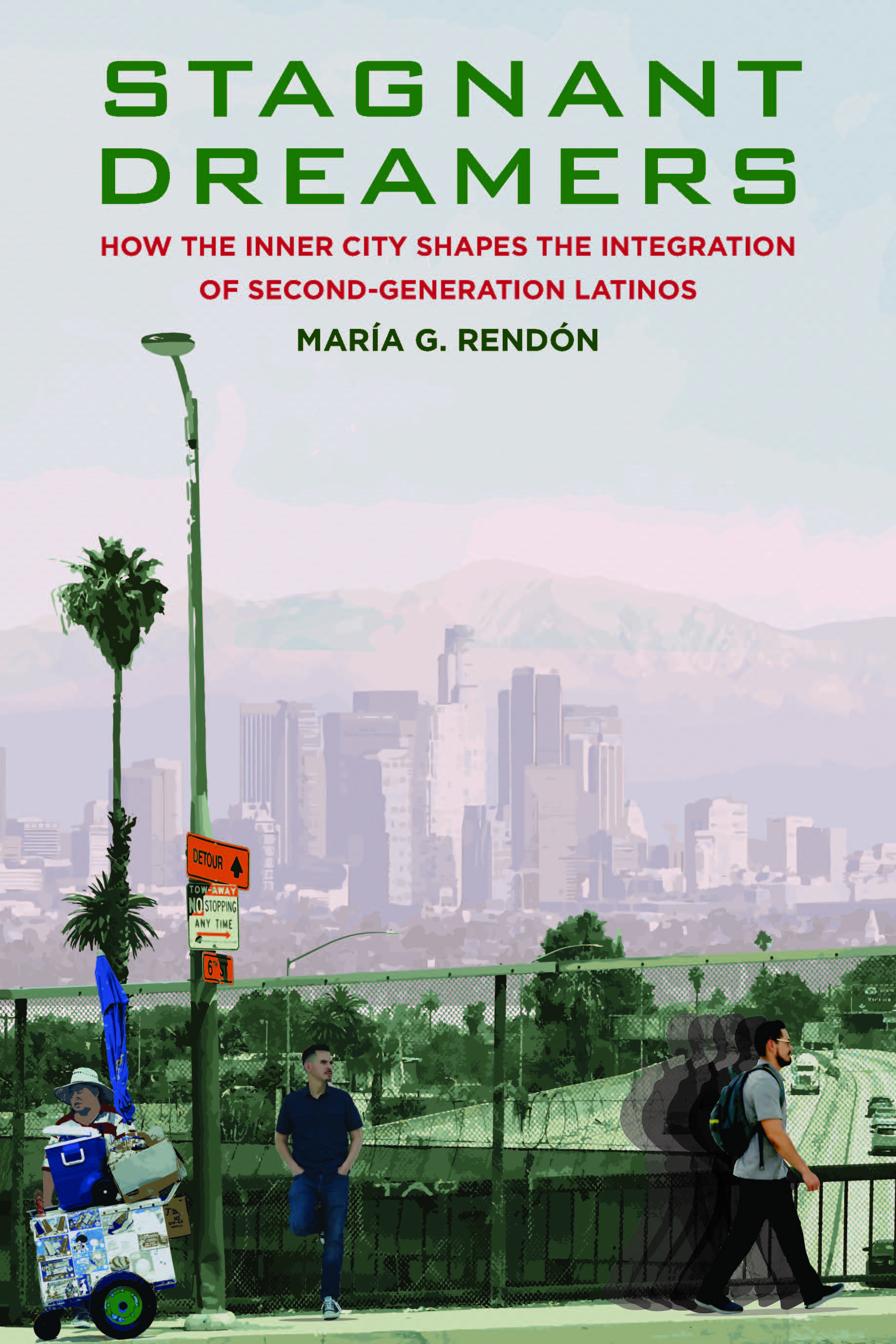
María Rendón’s new book examines inequality and integration challenges
By Mimi Ko Cruz
While today’s political climate has increasingly turned against immigrants, the children of Latino immigrants growing up in low-income neighborhoods have not given up on the American Dream, according to María G. Rendón’s new book, “Stagnant Dreamers: How the Inner City Shapes the Integration of Second Generation Latinos.”
 In “Stagnant Dreamers,” Rendón, assistant professor of urban planning and public policy, follows 42 young Latinos from two high-poverty Los Angeles neighborhoods as they transition into adulthood. It opens with the immigrant parents of the 42 men. The author captures their story of migration and settlement in Los Angeles during turbulent times — the peak years of urban violence.
In “Stagnant Dreamers,” Rendón, assistant professor of urban planning and public policy, follows 42 young Latinos from two high-poverty Los Angeles neighborhoods as they transition into adulthood. It opens with the immigrant parents of the 42 men. The author captures their story of migration and settlement in Los Angeles during turbulent times — the peak years of urban violence.
Her book describes the challenges her subjects face coming of age in the inner city and accessing higher education and good jobs. It demonstrates how family-based social ties and community institutions can serve as buffers against neighborhood violence, chronic poverty, incarceration and other negative outcomes.
Some of the men make their way to colleges and universities but struggle to get through, despite their determination to succeed, Rendón notes. She adds that institutions of higher learning need to do more to provide support, through such things as mentorship and other resources, to ensure success after second-generation Latinos complete their degrees.
Through their stories, Rendón emphasizes the importance of social support in helping second-generation immigrant youth succeed in life.
“I grew up in south Los Angeles in a community not too different or too far from these neighborhoods,” she says. “I am also second generation, my parents being from Mexico. As a female growing up in these neighborhoods, I did not experience my neighborhood the way males did, but I was nonetheless a product of my urban context — that partly explains my study. Today, I see myself in the face of our first-generation college students at UCI, many who come from similar communities, because I was one of them. We struggle to find community and mentors in these institutions. Sadly, some graduate without these resources and they deserve better. Those who become fully integrated into the university and its resources thrive and make quantum leaps during their time here — that is when you see our institutions of higher education correct for our gross neighborhood and school inequalities.”
Rendón recently answered questions about “Stagnant Dreamers.”
How long did you follow the 42 young men in your book?
“When I first met these young men, I was a graduate student and they were in their late teens and early 20s, right before the Great Recession. After I became a professor, I went back to follow-up with the Latino young men and their immigrant families about six years later to learn how they had weathered the economic downturn, the strategies they employed to get ahead, and if and how their views had changed about the American opportunity structure and their chances to succeed.”
Why did you write the book?
“My initial goal was to fill a hole in the academic literature. Today’s inner cities are increasingly Latino and yet we still have limited knowledge of these communities and how residents there fare, in particular how America’s urban conditions shape Latino’s social mobility patterns. The urban sociological literature has captured well the conditions of poor, black neighborhoods and the consequences of growing up in such communities. Less work exists on Latinos. There is important research on the immigrant experience, including research on Latino youth, particularly in schools. Yet we know less about children of immigrants in their young adult years and how growing up in American’s urban neighborhoods has shaped their life chances. In the process of writing, I came to realize it was important to write about the complexity of the Latino experience, including the diverse experience for those of us who have grown up in such communities. Too often, there is a stereotypical narrative of the inner city, particularly of Latino young men and I felt it was important to provide a more comprehensive depiction of them.”
Why?
“I think there are powerful, dominant narratives of who inner city Latino young men are — most circulate around their criminality. My research shows that most of these young men have goals and dreams about succeeding in this country and start their transition to adulthood pursuing different paths to achieve this. The book introduces readers to a wide range of inner city young men — from those who graduate high school and go straight to work, to the Ivy League graduate and those who navigate the community college, or never complete high school. I show how urban conditions — violence and segregation — impinge on the lives of all these young men and shape their social mobility paths. I explain what allows some young men to get ahead, while others sink deeper into poverty and why most remain working class.”
What were some of your most surprising findings?
“Perhaps it’s not surprising to some but the book shows clearly why a college education alone is not a ticket to the middle class. Education matters greatly for the knowledge and skill sets we pick up along the way, but it can only open opportunities for first-generation, working class students to the extent to which they are connected to institutional resources — mentors, programs, other institutions outside the university. It is only through the support of these ‘leverage ties’ that these students can materialize the benefits of higher education.”
What do you want readers of “Stagnant Dreamers” to learn?
“I want my readers to learn about the goals, hard work and perseverance that exist in Latino immigrant communities — including our most segregated and poorest communities — and the multiple pitfalls inner city, second-generation Latinos encounter in their pursuit for the American Dream. I hope readers come to appreciate the multilayered challenges this community faces, the underappreciated community resources that help them get by in a context of rising inequality and promising avenues that can ensure more of these young men thrive and reach their goals.”
The following is an excerpt from “Stagnant Dreamers”:
When I first met Osvaldo in 2007, he was juggling three part-time jobs that paid minimum wage. He was soon to be a father and was so desperate for a good paying job that he “felt like shooting myself in the head.” He considered selling drugs — “at least for a little while so I can stack up some money” — and “thought about jacking people…someone with a nice car.”
The violence and social disorder in American urban neighborhoods challenges the successful integration process of the Latino second-generation, but Osvaldo had dodged most of the risks. He had avoided for the most part getting caught up with risky ties and behavior, and he had completed high school and he had an associate’s degree. He was not among the nine participants who had been arrested. He was not “disconnected” from work and school and never had been, much like the majority of the young men in this study and the majority of second-generation Latino young men in the United States. He was also typical in that he struggled to establish a socioeconomic foundation that would allow him to prosper over time.
Osvaldo’s mother, Rosa, had bussed Osvaldo out of Central City in middle and high school because she was concerned about violence at the neighborhood schools. Osvaldo noted, rolling his eyes, she felt that “her kids deserved better.” He hated the affluent schools where “stuck up” students made “fun of the South Central kids with faded clothes,” he recalled. He threatened to drop out of school altogether, so Rosa allowed him to attend Central City High in his senior year. While he reconnected with peers who were caught up in neighborhood conflicts, he did not get caught up himself. Osvaldo noted, “out of all my friends I was the only one to graduate…all either got kicked out, in jail, dropped out.”
Osvaldo planned to go straight to work after high school but, in his words, Rosa told him, “If you don’t go to school, cabron, you’ll have to pay rent!” So Osvaldo attended community college for three years while working thirty hours a week at the airport earning $10.83 an hour. He earned his associate’s degree in criminal justice….
Osvaldo surmounted the risks of his neighborhood but still hit a wall in the labor market. … Osvaldo wondered if part of the problem was his interview skills. He often got nervous, but asserted, “I’ll go dressed nice. I shave, wear slacks, button-up shirt, sometimes a tie …
Osvaldo decided to enroll at a state university, but he had little faith that a college degree would help his job search. He knew people without degrees getting paid more than he was…Visibly upset, Osvaldo said, “I have a high school diploma and a little bit of college and nothing! ...”
Osvaldo has a realistic understanding of the importance of social ties in the job market. He told me, “jobs are based on who you know. … Look, if we both apply for the same position and we have the same ratings (evaluation) but they know one of us, guess who is getting the job?”